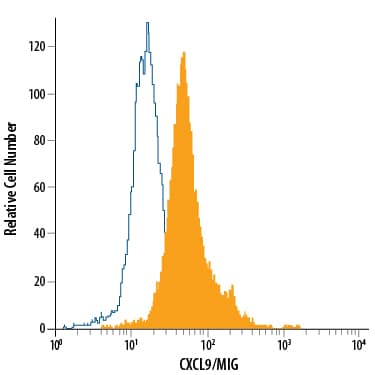Human CXCL9/MIG Fluorescein-conjugated Antibody Summary
Thr23-Thr125
Accession # Q07325
Customers also Viewed
Applications
Please Note: Optimal dilutions should be determined by each laboratory for each application. General Protocols are available in the Technical Information section on our website.
Scientific Data
 View Larger
View Larger
Detection of CXCL9/MIG in THP‑1 Human Cell Line by Flow Cytometry. THP-1 human acute monocytic leukemia cell line treated with Recombinant Human IFN-gamma (Catalog # 285-IF) in the presence of Monensin for 24 hours was stained with Mouse Anti-Human CXCL9/MIG Fluorescein-conjugated Monoclonal Antibody (Catalog # IC392F, filled histogram) or isotype control antibody (Catalog # IC002F, open histogram). To facilitate intracellular staining, cells were fixed with Flow Cytometry Fixation Buffer (Catalog # FC004) and permeabilized with Flow Cytometry Permeabilization/Wash Buffer I (Catalog # FC005). View our protocol for Staining Intracellular Molecules.
Preparation and Storage
- 12 months from date of receipt, 2 to 8 °C as supplied.
Background: CXCL9/MIG
CXCL9, a member of the alpha subfamily of chemokines that lack the ELR domain, was initially identified as a lymphokine-activated gene in mouse macrophages. Human CXCL9 was subsequently cloned using mouse MIG cDNA as a probe. The CXCL9 gene is induced in macrophages and in primary glial cells of the central nervous system specifically in response to IFN-gamma. CXCL9 has been shown to be a chemoattractant for activated T-lymphocytes and TIL but not for neutrophils or monocytes. The human CXCL9 cDNA encodes a 125 amino acid (aa) residue precursor protein with a 22 aa residue signal peptide that is cleaved to yield a 103 aa residue mature protein. CXCL9 has an extended carboxy-terminus containing greater than 50% basic aa residues and is larger than most other chemokines. The carboxy-terminal residues of CXCL9 are prone to proteolytic cleavage resulting in size heterogeneity of natural and recombinant CXCL9. CXCL9 with large carboxy-terminal deletions have been shown to have diminished activity in the calcium flux assay. A chemokine receptor (CXCR3) specific for CXCL9 and IP-10 has been cloned and shown to be highly expressed in IL-2-activated T-lymphocytes. The E. coli-expressed CXCL9 preparations produced at R&D Systems have been shown to contain greater than 80% full length CXCL9.
- Loetscher, M. et al. (1996) J. Exp. Med. 184:963.
- Liao, F. et al. (1995) J. Exp. Med. 182:1301.
- Vanguri, P. (1995) J. Neuroimmunol. 56:35.
Product Datasheets
Citations for Human CXCL9/MIG Fluorescein-conjugated Antibody
R&D Systems personnel manually curate a database that contains references using R&D Systems products. The data collected includes not only links to publications in PubMed, but also provides information about sample types, species, and experimental conditions.
2
Citations: Showing 1 - 2
Filter your results:
Filter by:
-
The effect of human placental chorionic villi derived mesenchymal stem cell on triple-negative breast cancer hallmarks
Authors: AT Alshareeda, E Rakha, A Alghwainem, B Alrfaei, B Alsowayan, A Albugami, AM Alsubayyil, M Abomraee, NK Mohd Zin
PLoS ONE, 2018-11-20;13(11):e0207593.
Species: Human
Sample Types: Whole Cells
Applications: Flow Cytometry -
Flow-cytometric analysis of cytokine production in human paracoccidioidomycosis.
Authors: Mamoni RL, Blotta MH
Cytokine, 2006-10-11;35(3):207-16.
Species: Human
Sample Types: Whole Blood
Applications: Flow Cytometry
FAQs
No product specific FAQs exist for this product, however you may
View all Antibody FAQsIsotype Controls
Staining Reagents
Reviews for Human CXCL9/MIG Fluorescein-conjugated Antibody
There are currently no reviews for this product. Be the first to review Human CXCL9/MIG Fluorescein-conjugated Antibody and earn rewards!
Have you used Human CXCL9/MIG Fluorescein-conjugated Antibody?
Submit a review and receive an Amazon gift card.
$25/€18/£15/$25CAN/¥75 Yuan/¥2500 Yen for a review with an image
$10/€7/£6/$10 CAD/¥70 Yuan/¥1110 Yen for a review without an image














